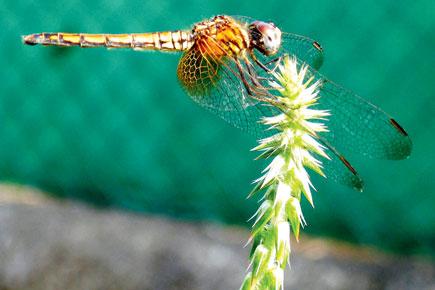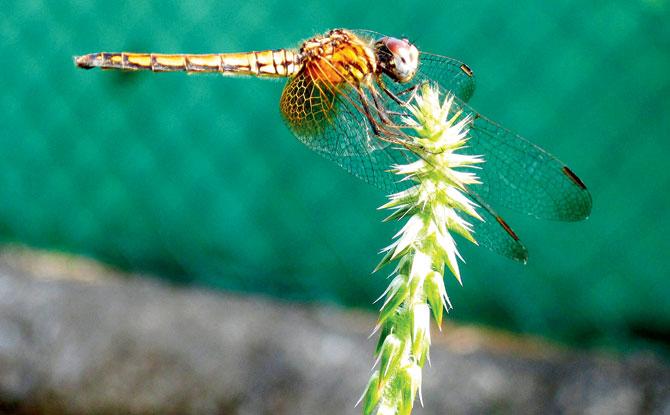Some among us must have been mighty cruel as kids, pinching the wings of butterflies or targeting squirrels with pellets shot from catapults and the commonest one, tying a thread to the abdomen of a dragonfly and flying it like a kite.

Dragonflies are aggressive hunters in both their adult and larval form
 Some among us must have been mighty cruel as kids, pinching the wings of butterflies or targeting squirrels with pellets shot from catapults and the commonest one, tying a thread to the abdomen of a dragonfly and flying it like a kite. As we grow up, empathy kicks in. But kids will be kids. The sooner we teach kids about nature the less chances of they harming it.
Some among us must have been mighty cruel as kids, pinching the wings of butterflies or targeting squirrels with pellets shot from catapults and the commonest one, tying a thread to the abdomen of a dragonfly and flying it like a kite. As we grow up, empathy kicks in. But kids will be kids. The sooner we teach kids about nature the less chances of they harming it.
I explain to the know-it-all young generation that dragonflies curb the spread of dengue, malaria or other mosquito or fly-borne diseases. Dragonflies are aggressive hunters in both their adult and larval form. Dragonfly larvae, also called naiads or nymphs, have very powerful jaws and due to their aquatic existence, they are feared predators of freshwater invertebrates, tadpoles as well as fish.
ADVERTISEMENT

Dragonflies are aggressive hunters in both their adult and larval form
Although adult dragonflies may survive anywhere between a few days to weeks, their larval life can run into years. Hence, destruction of wetlands (water bodies) such as lakes, rivers, streams and ponds or pollution caused by household phenyls, detergents, industrial effluents and land-filling, affects dragonfly numbers the most.
Fossil records indicate that these shiny-winged helicopter prototypes have been hunting on this planet for over 325 million years, which is way before most dinosaurs came into existence. In fact some of the ancient dragonflies were known to have wingspans measuring up to 75 cm.
Dragonflies have always inspired awe and respect among tribals, scientists and common people too. In Japan they are revered and considered symbols of courage and happiness. In Marathi too they are called Chattur, meaning clever. Hence, it is no surprise that we designed our helicopters after our dragonflies!
Some impressive phenomena that dragonflies exhibit are congregation, migration, their competitive mating strategies and a high diversity of habitat adaptability. Most dragonfly males are highly territorial and yet some species display congregations of thousand individuals of a single species.
One of the world’s most widespread dragonflies, the Wandering Glider is known to migrate from the African continent to India and back, covering a distance of easily over 15,000 km, spanning over 3-4 generations. An adult dragonfly can propel itself in six directions —upward, downward, forward, back, left and right - and fly at a speed of 100 kmph. Most insects can survive very narrow temperature ranges, but dragonflies live from sea level all the way up to 3,700 m and can withstand shade temperatures from 18-45C.
If you visit the Kanheri Caves, you will find a pepper-coloured dragonfly called the Granite Ghost, which hides perfectly on the rocks and breeds in the rock pools outside the caves.
My personal favourite has been the Parakeet Darner which is bright green dragonfly and resembles a small helicopter with a large cockpit.
There is a very closely-related group, the damselflies, which occupies similar habitats and are more slender and elegant, although equally aggressive hunters. I conclude by pointing out that, if your area doesn’t harbour enough dragonflies, there are two major inferences to be drawn — one that all wetlands in your area have been destroyed and secondly, there is
a high risk of you and your family coming down with dengue or malaria. So let’s work together to bring back the real dragon-slayers — our magnificent Dragonflies.
Anand Pendharkar is an ecologist, who is the founder of SPROUTS, an outdoors and eco-tourism company and SPROUTS Environment Trust, an NGO which works with youth and underprivileged groups and aims to provide a sustainable environment for all
 Subscribe today by clicking the link and stay updated with the latest news!" Click here!
Subscribe today by clicking the link and stay updated with the latest news!" Click here!







